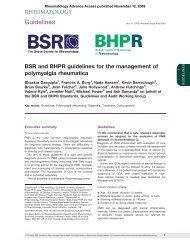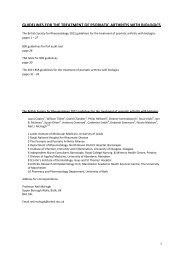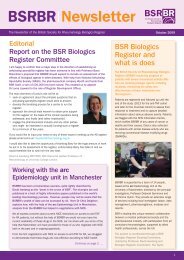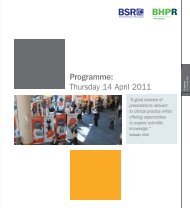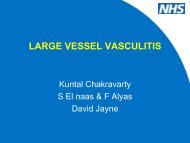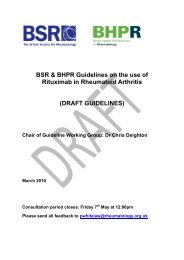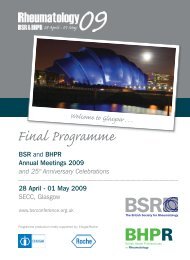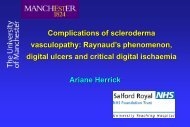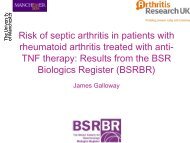Foot outcomes from the Chingford cohort study of
Foot outcomes from the Chingford cohort study of
Foot outcomes from the Chingford cohort study of
Create successful ePaper yourself
Turn your PDF publications into a flip-book with our unique Google optimized e-Paper software.
The <strong>Chingford</strong> 1000<br />
Womens’ <strong>study</strong>:<br />
Epidemiology <strong>of</strong> <strong>Foot</strong> OA<br />
Dr Cathy Bowen<br />
Pr<strong>of</strong> Nigel Arden<br />
Pr<strong>of</strong> Mike Doherty<br />
Dr Wendy Dreschler<br />
Dr David Stephenson
<strong>Foot</strong> & Lower Limb Research<br />
I<br />
n<br />
t<br />
e<br />
r<br />
n<br />
s<br />
h<br />
i<br />
p<br />
RA<br />
OA<br />
• FeeTURA<br />
• Ultrasound<br />
• MRI<br />
• Biomechanics<br />
• Pharmacology<br />
• <strong>Chingford</strong><br />
• Coast<br />
• Radiography<br />
• Biomechanics<br />
1. Cohort studies 2. Imaging 3. Function 4. Intervention
The <strong>Chingford</strong> Womens Study<br />
A well-established <strong>cohort</strong> <strong>of</strong> middle aged women<br />
http://www.chingford<strong>study</strong>.org.uk)
The <strong>Chingford</strong> Womens Study<br />
• Established in 1989 as a retrospective case-control <strong>study</strong> to<br />
determine prevalence rates <strong>of</strong> osteoarthritis (OA) and<br />
osteoporosis (OP) in middle-aged women in <strong>the</strong> general<br />
population, and to assess a number <strong>of</strong> known risk factors and<br />
<strong>the</strong>ir associations with <strong>the</strong>se two diseases.<br />
• It has since become a prospective population-based longitudinal<br />
<strong>cohort</strong> <strong>of</strong> women seen annually and described in detail.<br />
• It is listed by <strong>the</strong> NIHR as an important epidemiological resource<br />
and one <strong>of</strong> <strong>the</strong> few such <strong>cohort</strong>s with wide-ranging<br />
musculoskeletal data
1989 year 1 visit<br />
1,003 women<br />
1994 year 5 visit<br />
863 women<br />
1989<br />
1,353 women invited<br />
6 died<br />
66 moved away<br />
278 declined/did not respond<br />
15 died<br />
40 moved away<br />
44 dropped out<br />
41 did not attend<br />
1999 year 10 visit<br />
811 women<br />
2004 year 15 visit<br />
657 women<br />
2009 year 20 visit<br />
516 women<br />
40 died<br />
61 moved away<br />
80 dropped out<br />
11 did not attend<br />
99 died<br />
75 moved away<br />
85 dropped out<br />
87 did not attend<br />
158 died<br />
68 moved away<br />
125 dropped out<br />
136 did not attend<br />
Goulston LM, Kiran A, Javaid MK, Soni A, White KM, Hart DJ, Spector TD, Arden NK. Does obesity<br />
predict knee pain over fourteen years in women, independently <strong>of</strong> radiographic changes? Arthritis<br />
Care Res (Hoboken). 2011, Oct;63(10):1398-406.
The <strong>Chingford</strong> Womens Study<br />
At year 6, 872 participants returned for re-assessment (87% response rate) with a mean age:<br />
54 years (SD 17.9), height: 161cm (SD 5.9) and weight: 68.7Kg (SD 12.3).<br />
At year 15, 614 participants had returned for reassessment with a mean age <strong>of</strong> 69.2 years (SD<br />
5.8).<br />
At year 20, 516 participants had returned for re-assessment, <strong>the</strong> data for which is still being<br />
analysed.<br />
Radiographs <strong>of</strong> knees were taken at year 5 with 16.9% right and 19.4% left knees defined as<br />
having OA according to <strong>the</strong> K&L scale.<br />
At year 15, this had risen to 39.9% right and 35.7% left knees affected by OA.<br />
At year 20 …… Goulston LM et al (ongoing PhD <strong>the</strong>sis)
The <strong>Chingford</strong> Womens Study<br />
• Knee & Hip radiographs were read by<br />
investigators, using an atlas <strong>of</strong><br />
radiographic features with good<br />
reproducibility [Spector et al 1993;<br />
Hart et al 1994; Hassett et al 2003].<br />
• However, o<strong>the</strong>r than recording <strong>the</strong><br />
presence or not <strong>of</strong> first metatarsophalangeal<br />
(MTP) joint osteophytes and<br />
narrowing and angle <strong>of</strong> hallux valgus,<br />
<strong>the</strong> data has not previously been<br />
analysed with respect to foot OA.
<strong>Foot</strong> OA Study: Background<br />
• Our previous work has shown that older age, female gender and low socioeconomic status are known<br />
risk factors for OA [Arden & Nevitt 2006] .<br />
• In addition, knee OA is particularly associated with being overweight or obese and low activity [Badley<br />
& Ansari 2010] a factor that is set to become a major public health problem over <strong>the</strong> next few decades<br />
[Bitton 2009; Dixon 2009].<br />
• It is <strong>the</strong>se insights that have led us to <strong>the</strong> development <strong>of</strong> more targeted <strong>the</strong>rapeutic approaches and<br />
interventions for <strong>the</strong> management <strong>of</strong> hip and knee pain related to OA (OARSI) [Zhang et al 2007;<br />
Zhang et al 2008; Zhang et al 2009].<br />
• OA occurring within <strong>the</strong> feet, however, is less well understood.<br />
• To our knowledge, <strong>the</strong>re are currently no internationally agreed diagnostic guidelines or treatment<br />
codes specific for foot OA.<br />
• A recent systematic review <strong>of</strong> radiographic definitions <strong>of</strong> foot OA identified very few studies examining<br />
radiographic foot OA such that <strong>the</strong> authors were unable to estimate <strong>the</strong> population prevalence <strong>of</strong><br />
radiographic foot OA [Trivedi et al 2010].<br />
• ‘The clinical assessment <strong>study</strong> <strong>of</strong> <strong>the</strong> foot’ (CASF) <strong>study</strong> proposal is <strong>the</strong> implementation <strong>of</strong> a three year<br />
prospective observational <strong>study</strong> <strong>of</strong> foot pain and foot OA, (Roddy et al 2011). Within <strong>the</strong> CASF <strong>study</strong>,<br />
<strong>the</strong> focus is on investigation <strong>of</strong> participants over 50 years <strong>of</strong> age in <strong>the</strong> general population who have<br />
experienced foot pain i.e. symptomatic OA.
The <strong>Chingford</strong> Womens Study<br />
No<br />
200<br />
150<br />
100<br />
50<br />
3.6%<br />
Number <strong>of</strong> participants<br />
mentioning foot pain<br />
4.8%<br />
15.9%<br />
17.1%<br />
14.9%<br />
18.3%<br />
Numbers are based<br />
on participants<br />
mentioning some<br />
pain in some area<br />
<strong>of</strong> <strong>the</strong>ir foot/feet in<br />
<strong>the</strong> past.<br />
0<br />
3 5 6 8 10 15<br />
Year
<strong>Foot</strong> OA Study: Aims<br />
• The specific aims <strong>of</strong> our research are to develop a detailed<br />
understanding <strong>of</strong> <strong>the</strong> epidemiology, risk factors and<br />
associations <strong>of</strong> OA occurring within <strong>the</strong> feet in <strong>the</strong> general<br />
population at middle and older age.<br />
• An additional aim is to determine <strong>the</strong> lower limb<br />
biomechanical factors associated with radiographic foot<br />
OA.
<strong>Foot</strong> OA Study Design<br />
• The proposed <strong>study</strong> will utilise an observational <strong>cohort</strong><br />
design to investigate a general population who were<br />
recruited with no known lower limb OA or foot pain.
Collaborators<br />
• <strong>Foot</strong> Morf<br />
S<strong>of</strong>tware<br />
analysis<br />
• <strong>Foot</strong><br />
characteristics<br />
Oxford<br />
Pr<strong>of</strong> Nigel Arden<br />
Nottingham<br />
Pr<strong>of</strong> Mike<br />
Doherty<br />
• Clinical foot<br />
assessments<br />
Southampton<br />
Dr Cathy Bowen<br />
East London<br />
Dr Wendy<br />
Dreschler<br />
Dr Daivid<br />
Stephenson<br />
• Lower limb<br />
biomechanics
Comparator sample (The GOAL Study)<br />
• The main focus <strong>of</strong> our proposed <strong>study</strong> is to evaluate<br />
foot OA in a unique general population <strong>cohort</strong> <strong>of</strong><br />
middle aged women.<br />
• The <strong>Chingford</strong> <strong>study</strong>, by design, is representative <strong>of</strong><br />
middle aged women but accepts that men are not<br />
included.<br />
• As a comparator, we propose to fur<strong>the</strong>r investigate<br />
foot characteristics <strong>of</strong> middle aged male<br />
participants in <strong>the</strong> GOAL (Genetics <strong>of</strong><br />
Osteoarthritis and Lifestyle) <strong>study</strong> led by Pr<strong>of</strong>.<br />
Doherty.<br />
• The GOAL <strong>study</strong> included a sample <strong>of</strong> general<br />
population (N= 600) investigated as a case control<br />
‘one <strong>of</strong>f’ <strong>cohort</strong> (non-OA) but with <strong>the</strong> potential for<br />
re-questioning that population regarding foot pain.
Laboratory <strong>study</strong> Subset (n=50)<br />
Gait parameters: hip, knee and ankle<br />
joint motion (sagittal plane);<br />
plantar foot pressures (peak, time<br />
<strong>of</strong> peak, integral peak, mean force,<br />
time <strong>of</strong> footsteps); muscle strength<br />
(gastrocnemius, quadriceps).<br />
Muscle morphology: US measurement<br />
<strong>of</strong> gastrocnemius (cross sectional<br />
area, thickness, width, fascicle<br />
length, pennation angle)<br />
Function: Walking time; timed up &<br />
go; HAQ
To be continued….<br />
Clinical foot<br />
assessments<br />
Radiographic foot<br />
assessment<br />
Lower limb function<br />
assessment<br />
15
Acknowledgements:<br />
We would like to thank all <strong>the</strong> participants <strong>of</strong> <strong>the</strong> <strong>Chingford</strong><br />
Women Study and Pr<strong>of</strong>essor Tim Spector, Dr Deborah Hart<br />
and Dr Alan Hakim and Maxine Daniels for <strong>the</strong>ir time and<br />
dedication and Arthritis Research UK for <strong>the</strong>ir continued<br />
funding support to <strong>the</strong> <strong>study</strong>.<br />
16





